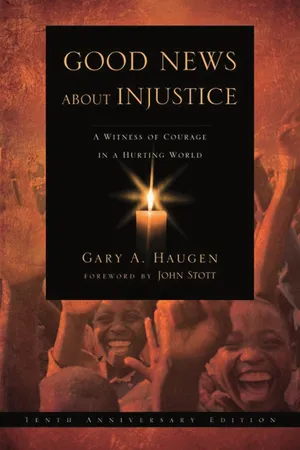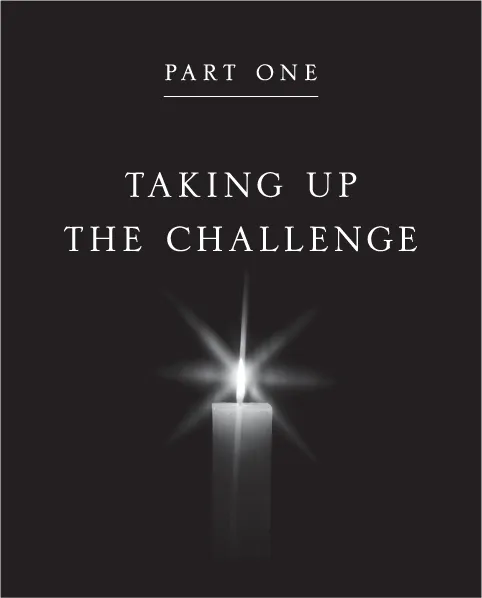
eBook - ePub
Good News About Injustice: 10th anniversary edition
A Witness Of Courage In A Hurting World
This is a test
- English
- ePUB (mobile friendly)
- Available on iOS & Android
eBook - ePub
Book details
Book preview
Table of contents
Citations
About This Book
The good news about injustice is that God is against it.
God is in the business of using the unlikely to accomplish justice and mercy. In this tenth-anniversary edition of Gary Haugen's challenging and encouraging book, he offers stories of courageous Christians who have stood up for justice in the face of human trafficking, forced prostitution, racial and religious persecution, and torture. This expanded edition brings up to date his work in calling for the body of Christ to act. Throughout, he provides concrete guidance on how ordinary Christians can rise up to seek justice throughout the world.
Frequently asked questions
At the moment all of our mobile-responsive ePub books are available to download via the app. Most of our PDFs are also available to download and we're working on making the final remaining ones downloadable now. Learn more here.
Both plans give you full access to the library and all of Perlego’s features. The only differences are the price and subscription period: With the annual plan you’ll save around 30% compared to 12 months on the monthly plan.
We are an online textbook subscription service, where you can get access to an entire online library for less than the price of a single book per month. With over 1 million books across 1000+ topics, we’ve got you covered! Learn more here.
Look out for the read-aloud symbol on your next book to see if you can listen to it. The read-aloud tool reads text aloud for you, highlighting the text as it is being read. You can pause it, speed it up and slow it down. Learn more here.
Yes, you can access Good News About Injustice: 10th anniversary edition by G Haugen in PDF and/or ePUB format. We have over one million books available in our catalogue for you to explore.

1
THE RAGE IN RWANDA
A SUBURBAN CHRISTIAN CONFRONTS GENOCIDE

I remember looking up from my newspaper during my bus ride to work one morning in the fall of 1994 and finding everything oddly in place. The AT4 bus was proceeding apace at 8:17 a.m. in the carpool zone. I was comfortably settled in my usual seat one row from the center double doors. My good-natured but nameless neighbors were sitting where they ought and respectively sleeping, reading or talking too loud, according to schedule. The low morning sun was where it should be, creating the glare that always forced me to look up from my paper at that point in the route. In that moment, pausing and looking around at all that American commuter normalcy, something inside me wanted to say, “Excuse me, friends, but did you know that less than forty-eight hours ago I was standing in the middle of several thousand corpses in a muddy mass grave in a tiny African country called Rwanda?”
ASCENSION: COMING BACK FROM A HELL ON EARTH
The Scriptures do not tell us very much about Jesus’ ascension, his sudden transport from earth to heaven. But there have been moments in my life when I wish they did. All we know is that he was standing with his rather earthy friends on an earthen hill trying as ever to explain something, when “he was taken up into heaven and he sat at the right hand of God” (Mark 16:19). That is all there is to it: one minute earth, the next minute heaven.
The very suddenness of it has always seemed to me something to ponder. What was it like for Jesus, as a man, to be transported in an instant from a horrifically fallen earth of darkness and death to a heavenly country of light and life—to a city that “does not need the sun or the moon to shine on it, for the glory of God gives it light” (Revelation 21:23)? What sort of mental adjustment, if we may call it that, was required to move so suddenly from the nightmarish world of the cross—a world of betrayal and torture, of blood lust and wailing women—to paradise? What was it like for the divine Man in heaven to exchange in a moment the stench of death and his own encrusted grave clothes for the very fragrance of life, a white robe, a golden sash and a seat at the right hand of the throne of God—to be home at last with his Father, where “there will be no more death or mourning or crying or pain” (Revelation 21:4)?
These may be idle questions, but they have come to me with particular force as I have struggled with the unreality of my own ascension experiences—moments when I have been transported with almost ethereal speed from a hell on earth to a heaven on earth. In a matter of hours I have traveled from the slippery mud and corpses of mass graves in Rwanda to my usual seat at the right hand of my neighbor on our dependably boring and climate-controlled bus ride to my office in Washington, D.C. I remember reclining on a comfortable living-room couch, among friends and family in California, talking about soaring real estate values in Orange County when only days before I had been exhuming the remains of a woman raped and butchered by soldiers in the Philippines. Similarly, I recall watching from my train window as a low summer sun cast a Norman Rockwell glow across Little League fields in Connecticut when only days before I had been in a country where boys of a similar age but of a different color were being beaten like animals by the South African police.
I don’t know whether Jesus experienced dreams while he was here on earth or whether he felt as if he had awakened from a particularly bad one when he found himself back in heaven after his ascension from the earth. But I have certainly felt that dreamlike separation from reality when I have returned from these hellish places around the world. In no time at all it begins to feel as if the nightmare I came from in Rwanda or the Philippines or South Africa has taken place not in another country but on another planet. Back home, it simply does not feel real anymore.
Thus my sudden urge to make that announcement about the Rwandan genocide to unsuspecting fellow bus commuters came not from a desire to shock them but from a desire to somehow affirm for myself the human reality and relevance of my own experience. Could it really be true, and could it really have anything to do with me, that in a period of about six weeks in the spring of 1994, nearly one million defenseless women and children were hacked to death by their neighbors in the towns and villages of Rwanda?
I remember very well what I was doing in the spring of 1994. I was trying to assemble cribs for twin girls who were coming into our home, ready or not. I was trying to match wits, and losing, with the class clown in my sixth-grade boys’ Sunday-school class. I was seeking every advantage, and losing, in my effort to trade in our Honda Civic for a Taurus station wagon. I was prevailing in my arguments in a trial in federal court in Alabama, enjoying an occasional jog along the Potomac River in Washington, D.C., and denying that I had ever watched Melrose Place on TV.
Like most Americans in the spring of 1994, I was also starting to see horrible stories in the newspapers about some kind of “tribal warfare” in an African country I had never heard much about. Then I saw pictures on the evening news of bloated bodies floating down a river and heard commentators talking about genocide. Apparently thousands, maybe even millions, of Tutsis were being slaughtered by their Hutu compatriots in a genocidal hysteria sweeping across Rwanda. But like most of the great ugliness transmitted by TV across the world and into my living room, the terror in Rwanda just did not seem real. It seemed true, but not real—not to me. I did not dispute the accuracy of the reports, but they might as well have been pictures from Sojourner on Mars or reports about people who lived in ancient Rome or statistics about how many bazillion other solar systems are in the Milky Way—all true enough, but not real. Not real like my kids when they are sick, not real like my job when I am behind in my work, not real like my neighbors when one of them has been in a car accident, not even real like my Midwestern compatriots when they have been flooded out of their homes.
MEETING THE TRUTH IN RWANDA
But then in the fall of 1994 I went to Rwanda. Only forty-eight hours before taking my seat on the AT4 commuter bus, I had been in Kibuye, Rwanda, a beautiful town sprawling on the banks of Lake Kivu and clinging to the green highlands of eastern Rwanda—and a horrible town—where thousands of Tutsis (mostly women and children) were hacked and beaten to death by their Hutu neighbors over a period of several days. I was in Kibuye directing the U.N.’s genocide investigation in the country, on loan to the United Nations from the U.S. Department of Justice. My job was to march down a list of mass grave and massacre sites provided by U.N. military intelligence and deploy international investigative teams to gather preliminary evidence against the perpetrators. The evidence would eventually be turned over to the International Criminal Tribunal for Rwanda, which was just being established to bring the murderers to justice. There in Kibuye and in scores of other towns and villages across the country, the nightmare became real for me.
Kibuye was my last mass grave site before I was to head back home to America. One of my twin infant daughters had been stricken with meningitis, and while our worst fears had passed and she was on the mend, it was time for me to return to my family. For this final project in Kibuye I brought four other members of my U.N. investigative team: Luc, a jovial, bear-sized criminal lawyer from French Canada; Jim, a delightfully wry police officer from Northern Ireland; Thaddi, a Rwandan school teacher who served as interpreter; and Nehemiah, our U.N. military officer from Zimbabwe who mostly missed his family back home. We arrived in Kibuye after a jarring, five-hour, four-wheel-drive journey from our headquarters in Kigali.
Once we arrived, the most dangerous part of our assignment was over. Though low-level civil war still claimed the country, land mines peppered the fields and bandits roamed the land, the greatest danger was simply traveling on the roads. Narrow, mud-washed trails over sheer mountain cliffs wound their way over the eastern highlands and delivered us to the banks of Lake Kivu—one of the great, deep-blue lakes of Africa—separating Rwanda from Zaire (now the Democratic Republic of the Congo). Of course, the breathtaking beauty of the lake and its lush tropical shores were marred by human horror, for we knew that many corpses found their way to the placid waters during the genocide only a few months before.
Murder investigations generally begin where the bodies are, and as we arrived in Kibuye, I knew this meant that we would be heading for the biggest church in town—the Catholic cathedral and the adjoining Home St. Jeans, a complex of residential and educational buildings. The large, rough-hewn stone cathedral stood sturdy and squat on a peninsula over the lake. The stone and concrete interior had been scrubbed out, but as we stepped inside, we found the lingering, overpowering essence that could not be cleansed from the stones—the stifling, unnatural odor of a mass sepulcher. For within these walls and on this floor, hundreds of defenseless children, mothers, brothers and grandmothers had been hacked and clubbed to death in a murderous binge of torture and slaughter just months ago. Now the cathedral was empty, except for a lone, deranged man in rags, who had made the empty hall his home and was seen spending hours on his knees mumbling before the altar.
GATHERING ALL THE FACTS
Our task in the coming days was to conduct an investigative site survey, locate survivors and other witnesses and begin to account for the bodies. The story that emerged was a familiar one. On April 6, 1994, the president of Rwanda was killed in a mysterious plane crash in Kigali, the capital city. Almost immediately extremist Hutu factions within the government and the military joined with extremist Hutu paramilitary groups across the country to incite a murderous hysteria against Tutsis and moderate Hutu. The quasi-ethnic divisions between Hutu and Tutsis in Rwanda had been highly politicized over the years, with each side viewing the struggle as a zero-sum game between governance and extinction. Claiming that Tutsis had killed their president and were now coming to slaughter all Hutu, these fanatical Hutu leaders used government military forces, citizen militia and local mobs to start hunting down and killing the Tutsis in their communities. In the days following the plane crash Tutsis in and around Kibuye began to hear of prominent members of their community being dragged from their homes and murdered. Disheveled Tutsi corpses began to appear in the streets.
By April 17 the violence and hysteria had reached a full boil in Kibuye. Seeking safety in numbers and following the orders of the provincial governor and the mayor, hundreds of Tutsi men, women and children huddled together at the cathedral and the Home St. Jeans complex. During times of ethnic conflict in years past, many Tutsi had found sanctuary within the sacred walls of churches across the country. So as the fever of violence escalated in Kibuye and across Rwanda, the churches became packed to the rafters with thousands of trembling women and children seeking refuge. For the hundreds huddled in the Kibuye cathedral, however, there would be no refuge, only a lure, a trap and a grave.
On that day in April the provincial governor and mayor, who had ordered all Tutsi to the cathedral (ostensibly for their safety), ordered that the complex be surrounded. Eventually a for...
Table of contents
- Cover
- Title
- Copyright
- Contents
- Foreword by John Stott
- Preface to the Tenth Anniversary Edition
- Preface to the First Edition
- Acknowledgments
- Part 1: Taking Up The Challenge
- Part 2: Hope Amid Despair: God’s Four Affirmations About Justice
- Part 3: Real-World Tools For Rescuing The Oppressed
- Appendix 1 Reflection and Discussion Guide
- Appendix 2 Suggested Internet Sites
- Appendix 3 Justice Scripture Verses
- Appendix 4 Book Resource Guide
- Appendix 5 Advice to Students Considering an International Human Rights Career
- Additional Resources for Study and Reflection
- Notes